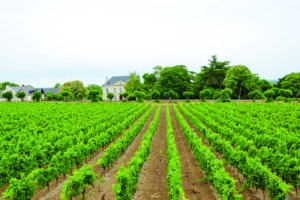
 A GUIDE TO MAXIMIZING THE EDUCATIONAL VALUE AND NETWORKING OPPORTUNITIES OF IN-PERSON WINERY TRIPS
A GUIDE TO MAXIMIZING THE EDUCATIONAL VALUE AND NETWORKING OPPORTUNITIES OF IN-PERSON WINERY TRIPS
By Laura Burgess
For most wine professionals, nothing beats getting out of the office and into the vineyards with the winemakers and vineyard managers responsible for crafting the wines they work with every day. On-the-ground tasting opportunities can also cement wine education in a way that book study cannot.
The planning minutiae and execution of those visits, however, rarely elicit the same joy. To maximize the educational and networking benefits of a trip to wine country, Beverage Media gathered best practices from experts across the industry.
DO YOUR HOMEWORK
To get the most from any winery visit, it’s important to have a foundation in the region as well as the specific winery you’re visiting and the people who work there. “The first thing you should do is study the place you’re going to before you go there,” says Jeffrey Porter, the wine director for the Barclays Center in Brooklyn and the host of Sip Trip. “Know who you’re meeting and do some investigation because when you’re there, you can ask deeper questions and get more information.”
“In Napa Valley, we have over 400 estate properties and every single estate offers something different,” echoes Genevieve Echavarrie, the general manager of Memento Mori in Napa Valley. “The most important thing is to know who you’re visiting and do your research.”
Producer websites detail background for each individual winery, while appellation and grape variety basics can be found in regional websites, guides, and reference books like The World Atlas of Wine and The Oxford Companion to Wine. George Athanas, who has organized private and sponsored wine travel for over two decades in partnership with Wines of Greece, notes that when they help organize travel for wine professionals, they often send background information in advance.
CREATE A GOAL FOR EACH TRIP
The most effective trips to wine country also offer broader insights into the producer side of the industry, so setting a clear goal ensures a valuable return on the time and money invested in each trip. When creating a goal, it’s best to find a topic— such as a specific soil series, grape variety, or winemaking style—that aligns with your current beverage program, exams, or personal interests. Then, seek out wineries or regions that suit that goal.
When setting up a visit, it’s helpful to ask if it’s an option to go into the vineyard or cellar, which can educate about viticulture and production in a hands-on way that book study can’t. “It makes it a cohesive experience with the wine,” says Erik Segelbaum, the Denver-based founder of wine consulting firm Somlyay and the former beverage director for Starr Restaurants. “You’ll remember it more when you’ve been there, seen the slopes, the landscape, the terroir. It creates a three-dimensional experience.”
MAKE APPOINTMENTS THROUGH PROFESSIONAL CHANNELS
Making tasting appointments in advance is crucial whether the winery has an established tasting room or not. Though it’s always an option to make a reservation through an online portal, if the winery uses one, reaching out through a professional connection offers a better chance that a winemaker or vineyard manager will host.
“If you don’t have a relationship with the winery, my recommendation is to go through the importer or distributor,” says Porter. “They want to know that you’re there. Even today, I like to tell importers and distributors when I’m visiting their wineries, just as an FYI.” This is easier for buyers thanks to their relationships and purchasing power, but it holds true for anyone in the industry, as roles can always change. “Let them know what your role is, even if you’re not a buyer,” says Segelbaum. “Any winery that’s worth their salt is going to recognize the value of the loyalty of a young somm. There’s the potential for a much larger ROI.” Porter agrees, noting that most importers and distributors recognize the “potential for further sales if you understand that wine better.”
Regional organizations may also be able to help secure appointments, and even if a winery doesn’t have a formal tourism offer, it never hurts to reach out directly. When reaching out to a winery in a non-English-speaking country, Porter often drops his request into Google Translate and copies the translation above his original message in English.
ALWAYS ASK WHAT’S INCLUDED
“Being candid is the way to go,” says Sally Srok, the hospitality director for Arista Winery, who advises guests to be open and upfront with their hosts whenever possible. It is especially important to inquire about vineyard visits in advance, since many wineries are not located on the same property as their source vineyards.
While it’s likely that a visit set up by an industry connection or regional body will be hosted by a winemaker or vineyard manager, reservations made through a consumer-facing site will likely be hosted by tasting room staff, so it’s good to clarify. While most estates offer free tastings to professionals—neither Porter nor Segelbaum could recall paying a tasting fee recently—it’s never a good idea to assume that a discount will be applied, and guests should be gracious either way.
“It’s really up to the winery to extend that level of hospitality to a guest,” says Lauren Van Ness, the sales and hospitality director of Memento Mori, noting that inquiring about tasting fees or industry discounts should be handled during the reservation process.
“Unfortunately, we’re not afforded the luxury of being able to extend a discount to our industry friends. We hope that through our hospitality approach and our style of hosting that everyone can experience the joy behind our wines and get a sense of our generosity, and understand that generosity looks different for every winery.”
It’s likewise best to share details about the group if you’re visiting with non-industry professionals. “If you work in the industry and you’re visiting Northern California with three friends, I think it’s great to call ahead and say ‘this is a social visit,’” says Srok. “You don’t want to pretend the whole group is industry if they’re not because the staff wants to be prepared to host you at an appropriate level for the whole group.”

PHOTOGRAPHY COURTESY OF JEFFREY PORTER
LIMIT DAILY WINERY VISITS
“It is impossible to try and do everything in a four- to seven-day trip,” says Athanas. “Try to focus on a particular region and the wines and winemakers of that region to really get an in-depth look at the wines, how they are made, and who is making them.” Also, if you’re booking a series of appointments, “plan more time than the map tells you the travel will be,” says Segelbaum.
To avoid burnout while experiencing the maximum of a place, Van Ness suggests diversifying wine experiences throughout a trip. “I like to go to a few newer wineries that are offering approachable wines, plus some classic producers, and then a few bottle shops and bars where you can keep learning from the staff,” she says.
PREP YOUR PALATE
“[Make] sure to carry some sort of carbonated beverage to recalibrate your palate between each tasting,” says Echavarrie.“A lot of the wines are going to be young or barrel samples, which can have a really huge effect on your palate.” While most wineries will have water on hand, it doesn’t hurt to bring your own in addition to simple, palate-cleansing snacks. “It’s really easy to get palate fatigue, and at some point, you’ll be unable to keep track of all the details,” adds Echavarrie.
ALWAYS FOLLOW UP
Winery visits are also excellent networking opportunities that can continue on well after the trip itself, so always ask for the business card of the tasting host.
“We’re in a relationship-based business,” says Segelbaum. Handwritten thank-you notes are the gold standard, but emails are perfectly suitable as well. If a sales rep, public relations firm, or regional organization helped coordinate the experience, send a thank you message to them as well.
“Feedback is such a powerful thing,” says Echavarrie. “Using good manners and saying thank you is one of the most important things to do.” Even if you’re not in a position to purchase from the winery for your job now, the relationship could become even more valuable in the future. “Even if it’s a Napa Valley winery and you have an all-Italian wine list, things change,” says Segelbaum. “Somms move on and you can reach out for partnership later.”
This is also a great chance to reciprocate the hospitality that was shown to you during your visit. “If you work at a restaurant, always invite the producers to see you the next time they’re in town,” says Porter. In the end, there’s no better way to learn about the wine industry than by visiting producers, and a genuine interest is the most important thing to bring with you. “When you’re there, be earnest and be giddy,” says Porter. “People like when you are excited to be there. Don’t be too cool for school.”
“This community starts to form when we really show up with genuine interest and support for other people’s business,” adds Srok. “It just naturally reciprocates.”











